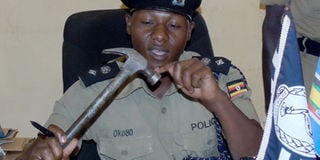How criminal gangs are terrorising Gulu residents

Exhibits. Former Gulu District police commander Martin Okoyo displays a harmer and some bullets recovered from suspected iron bar hitmen in Gulu Municipality in 2017. PHOTO BY JULIUS OCUNGI.
What you need to know:
Some of the hotspots for criminal activities include Layibi A and B villages in Tegwana Parish, Aywe Sub-ward, Nakasero Village in Labourline Parish, all in Pece Division, Cuk Pa Oweka market and Godown Village in Techo Parish, both in Layibi Division
Gulu Municipality is arguably the fastest growing cosmopolitan town in northern Uganda ever since the guns fell silent, ending more than two decades of insurgency orchestrated by the Lord’s Resistance Army (LRA) rebels.
This has spurred development, increased social service provision and population because of the swelling number of people migrating from various parts of the country to tap into opportunities here.
Recently, Cabinet approved the elevation of Gulu Municipality among other nine municipalities in the country into a city by July 1 next year.
However, besides the sprawling development, the municipality is grappling with rising crime cases.
A 2018 police annual crimes report ranked Gulu the eighth district with the highest criminal cases in the country, with a total of 3,569 cases reported between 2017 and 2018.
A number of organised street gangs commonly referred to as Aguu, have in the past months taken control of several streets within the four divisions of Pece, Bar-dege, Layibi and Laroo during night time, waging attacks on especially unsuspecting boda boda riders, passengers and pedestrians.
Police names some of the ring leaders as Owegi, Okot Kuba, Funga, Taban and Striker.
On Thursday last week, gunshots rocked Gulu Municipality as a combined security force of police and the army, fired bullets to contain a fight that erupted between street gangs and a vigilante group in Industrial area, Layibi Division.
More than 50 street gangs comprising young boys [between 13 and 18 years-old] wielding machetes and clubs stormed Industrial Area in Layibi Division at about 7pm to revenge against a vigilante group mobilised to man security in the area.
Following an upsurge in criminal cases in his area, Mr Jino Otti, the Industrial Area LCI chairperson, mobilised a total of 40 youth vigilantes about two months ago. The area harbours some of the most notorious criminals.
Reports Daily Monitor obtained indicate that the vigilantees had, however, become ruthless on the street gangs, prompting the Thursday fight.
Four people sustained severe injuries in the brawl that lasted nearly three hours before police and the army contained the situation.
The injured were identified as Alfred Moro, who was hacked on the head, Jamal Odong, a deaf and dumb man who was severely beaten, and two others only identified as Mugisha and Sunday. They are all admitted to Gulu Regional Referral Hospital.
The gangs
A source within the security circle, who didn’t want to be named because of the sensitivity of the matter, told Daily Monitor at the weekend that the street gangs were once street children in Gulu Municipality.
The source said the gangs opted to organise themselves into groups, with the main motive of looting and waging attacks on unsuspecting people for their survival.
“What is clear is that these gangs are now brave, owing to the number of years they have spent on the streets. They are well coordinated, they know how and when to strike. The formation of the vigilante group was a threat to their survival and they opted to show they can destroy them,” the source further said.
In 2014, the Gulu Municipality mayor, Mr George Labeja, ordered the arrest of more than 100 street children from the municipality, saying they had become a security threat.
The initiative, however, failed since most of those arrested were juveniles and couldn’t be kept at the Gulu Children Remand Home because of lack of space, food, among other challenges.
The Gulu Resident District Commissioner, Maj Santos Okot Lapolo, also the district security committee chairperson, acknowledged the surging levels of crime within the municipality, but noted that security officials are alert.
He attributed the growing criminal activities on the effects of the two decade LRA insurgency, high levels of poverty, drug abuse, irresponsibility of parents and guardians and the increasing development in the sub-region.
Maj Lapolo explained that many children were abandoned during the insurgency by their families, while others moved away from their homes to the streets due to various reasons, including domestic violence.
He said though the security personnel are doing whatever they can to contain the upsurge in criminal activities in the municipality, they face a number of challenges, including poor police investigations and light sentences handed to convicted thugs.
He, however, assured the residents that as security, they will not rest until the street gangs are all wiped out.
Vigilantes applauded
Mr Kelly Komakech, the Pece Division chairperson, said the formation of a community vigilante group was a good initiative to curb the growing crimes within the municipality. He, however, decried the attack on the group.
“The attack on the vigilante group sends a signal that some people are against peace efforts being made. We need to investigate why this attack was made against a group meant to keep peace,” Mr Komakech said.
Mr Osborn Ochieng, a security expert in Gulu Municipality, without mentioning names, alleged that there are people profiteering from the street gangs’ operations.
“How can these people operate and man their own territory yet police are there. There are definitely people ‘eating’ from their operations and activities,” he said.
The Aswa River Region police spokesperson, Mr Jimmy Patrick Okema, said by last weekend, the police had arrested 23 suspects in connection to the Thursday attack.
He noted that some of the suspects were found in possession of marijuana, knives, iron bars, house-breaking instruments, master keys and machetes.




